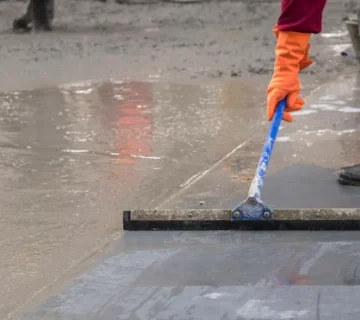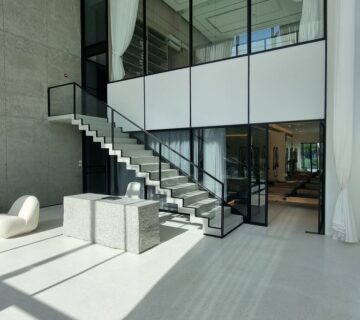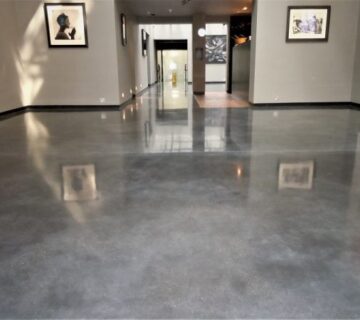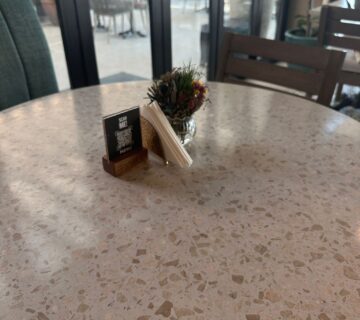Polished concrete is a durable and stylish flooring choice, widely used in homes and commercial spaces. However, growing concerns about slip safety have made it important to understand surface performance.
This blog covers the polished concrete slip rating standards, explaining what they mean, how slip resistance is measured, and what steps can be taken to improve safety if needed.
What Is the Polished Concrete Slip Rating and Why Does It Matter?
The polished concrete slip rating shows how safe a floor is to walk on, especially in areas where it might get wet or slippery. This rating is important in both commercial and public spaces to prevent accidents and meet safety rules.
It is measured using tests like the Pendulum Test Value (PTV), Dynamic Coefficient of Friction (DCOF), and R-ratings. These standards help building owners choose the right finish for safety and legal compliance.
How Is Slip Resistance in Polished Concrete Measured?
Slip resistance is very important for polished concrete. Measuring floor safety rating, friction measurement standards, and pedestrian surface safety are some basic safety aspects that need to be ensured. Here are some ways how slip resistance is measured in polished concrete:
Pendulum Test Value
- A rubber foot swings onto the floor surface.
- It is tested in both wet and dry conditions.
- The results are calculated as follows:
0-24 = high slip risk
25-35 = moderate risk
35+ = safe
Dynamic Coefficient of Friction
- This test measures actual grip while walking on the floor.
- If the results are over 0.24 then, the surface is considered a high traction surface.
- It is tested in wet conditions.
Ramp Test
- In this test, walking is done on an oil coated ramp.
- It is used in commercial kitchens and hospitals for commercial grip resistance.
- The rating ranges from R9 to R13:
- R9 = Low grip, suitable for dry indoor areas.
- R10–R11 = Moderate slip resistance, ideal for general use.
- R12–R13 = Strong grip, recommended for wet or greasy environments.
What Factors Affect the Slip Rating of Polished Concrete Floors?
Surface finish level
- The risk of slipping increases in glossy surfaces. High gloss floors usually have reduced polished floor safety unless anti-slip concrete coating is applied.
- Matte finish floors usually provide more friction.
- Satin finish is a decent option which gives balance.
Water, oil or dust on the floor
- The slip risk highly increases on a wet surface.
- Commercial grip resistance can fail if the surface has oil or grease on it.
- Dust build up also causes the floor to become slippery.
- Regular cleaning is important for maintaining floor safety ratings.
Type of sealer or densifier used
- Densifiers make the surface hard but slippery.
- Penetrating sealers are better because they provide more slip resistance.
- Products should be chosen according to friction measurement standards.
Foot traffic and floor usage
- The floor loses its grip gradually when there is more foot traffic.
- High traction surfaces are needed in crowded places.
- Periodic test results should be taken to maintain safety.
Can Polished Concrete Be Both Slip-Resistant and Glossy?
Yes, polished concrete can be both glossy and slip-resistant if the right balance is maintained. The shine of the surface doesn’t have to mean it’s unsafe.
With the use of anti-slip additives or special coatings, you can keep the sleek, modern look while improving surface grip. These treatments are especially helpful in residential areas like kitchens or living rooms where moderate safety and appearance matter.
For commercial spaces, where foot traffic is higher, extra traction might be needed so a slightly textured finish or lower sheen may work better.
Wet zones also benefit from coatings designed for slip-resistant flooring. Regular cleaning and testing with tools like DCOF or PTV help make sure the floor meets proper floor safety rating standards without losing its glossy appeal.
Where Are Slip-Rated Polished Concrete Floors Commonly Required?
Restaurants and cafes
- Oil, water, or food can fall on the floor.
- That’s why slip-resistant flooring is very important here.
- Anti-slip coatings help keep the shine while adding grip.
Hospitals or clinics
- Cleanliness and pedestrian surface safety are both important.
- Floors can get wet from spills or cleaning.
- High traction surfaces help protect both patients and staff.
Schools and educational buildings
- Kids walk and run fast, so grip and polished floor safety are needed.
- Areas like stairs, hallways, and washrooms are tested for slip risk.
- Schools must follow friction measurement standards.
Shopping centers
- These areas have high foot traffic and people often walk in with wet shoes.
- Entryways, food courts, and restrooms need commercial slip resistance.
- Some places require DCOF test results for insurance approval.
Industrial areas and warehouses
- Machines and tools are used, and oil or chemicals may spill.
- Floors are treated with anti-slip concrete coating for better grip.
- A strong floor safety rating is required by law to protect workers.
Wet prone areas
- These areas stay wet or moist, so slip-resistant flooring is a must.
- Instead of shiny finishes, textured or coated surfaces are better.
- In hotels, offices, and malls, gloss versus grip standards are checked.
How Can You Improve the Slip Resistance of Polished Concrete?
Use of anti-slip sealers
- Special sealers or anti-slip concrete coatings make the floor less slippery.
- These sealers have small particles that help balance shine and grip.
- You get slip-resistant flooring without losing the polished look.
Micro-etching the surface
- Micro-etching lightly roughens the surface.
- This adds more grip but still keeps the floor looking smooth.
- It works well in wet areas like lobbies or bathrooms.
Adding grit additives
- Grit (like fine sand or beads) is mixed into the sealer.
- It creates extra grip on the surface.
- This is great for commercial slip resistance in busy spaces.
Regular cleaning
- Dust, oil, or grease makes floors more slippery.
- Regular cleaning keeps the floor safe and clean.
Resealing worn areas
- With time, polished floors can lose their coating.
- Re-apply anti-slip sealers on these areas.
- This helps keep the floor within friction measurement standards.
Wrapping Up: Is a High Slip Rating Worth the Effort for Polished Concrete?
Achieving a high slip rating for polished concrete is worth the effort. Polished concrete offers a smooth, modern, and stylish finish. But safety should always come first.
With the right finish, sealer, or anti-slip treatment, the floor can be both attractive and safe. In public and commercial areas, slip-resistant flooring helps prevent slips and injuries. It also meets safety standards and passes inspections. Many building codes and insurance policies require a proper floor safety rating.
Before installation, the environment must be considered like moisture and foot traffic levels. Choosing a finish that offers both gloss and grip is essential. These steps reduce risk, save long-term costs, and deliver a polished surface that performs well and looks great.








No comment